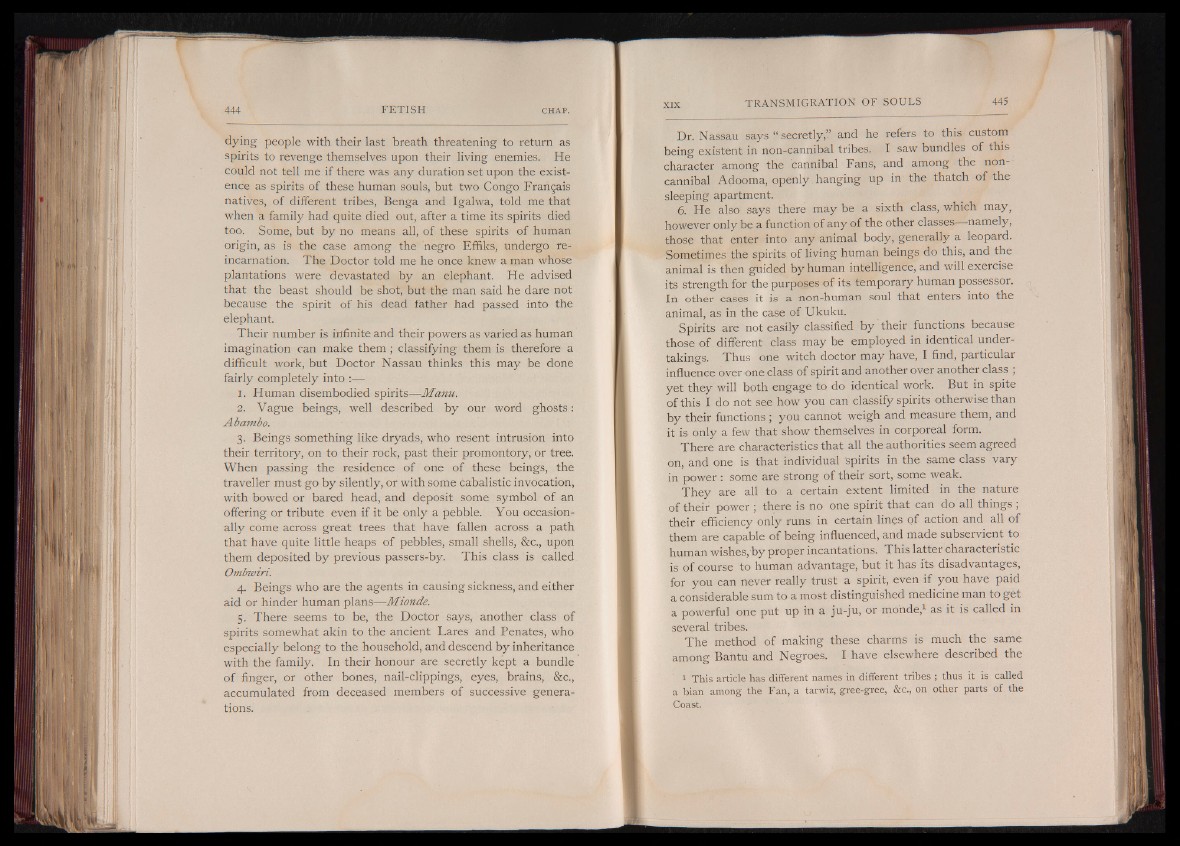
dying people with their last breath threatening to return as
spirits to revenge themselves upon their living enemies. He
could not tell me if there was any duration set upon the existence
as spirits of these human souls, but two Congo Français
natives, of different tribes, Benga and Igalwa, told me that
when a family had quite died out, after a time its spirits died
too. Some, but by no means all, of these spirits of human
origin, as is the case among the negro Effiks, undergo reincarnation.
The Doctor told me he once knew a man whose
plantations were devastated by an elephant. He advised
that the beast should be shot, but the man said he dare not
because the spirit of his dead father had passed into the
elephant.
Their number is infinite and their powers as varied as human
imagination can make them ; classifying them is therefore a
difficult work, but Doctor Nassau thinks this may be done
fairly completely into :-f|||i
1. Human disembodied spirits— Manu.
2. Vague beings, well described by our word ghosts :
A bambo.
3. Beings something like dryads, who resent intrusion into
their territory, on to their rock, past their promontory, or tree.
When passing the residence of one of these beings, the
traveller must go by silently, or with some cabalistic invocation,
with bowed or bared head, and deposit some symbol of an
offering or tribute even if it be only a pebble. You occasionally
come across great trees that have fallen across a path
that have quite little heaps of pebbles, small shells, See., upon
them deposited by previous passers-by. This class is called
Ombwiri.
4. Beings who are the agents in causing sickness, and either
aid or hinder human plans— Mionde.
5. There seems to be, the Doctor says, another class of
spirits somewhat akin to the ancient Lares and Penates, who
especially belong to the household, and descend by inheritance
with the family. In their honour are secretly kept a bundle
of finger, or other bones, nail-clippings, eyes, brains, &c.,
accumulated from deceased members of successive generations.
Dr. Nassau says “ secretly,” and he refers to this custom
being existent in non-cannibal tribes. I saw bundles of this
character among the cannibal Fans, and among the noncannibal
Adooma, openly hanging up in the thatch of the
sleeping apartment.
6. He also says there may be a sixth class, which may,
however only be a function of any of the other classes-—namely,
those that enter into any animal body, generally a leopard.
Sometimes the spirits of living human beings do this, and the
animal is then guided by human intelligence, and will exercise
its strength for the purposes of its temporary human possessor.
In other cases it is a non-human soul that enters into the
animal, as in the case of Ukuku.
Spirits are not easily classified by'their functions because
those of different class may be employed in identical undertakings.
Thus one witch doctor may have, I find, particular
influence over one class of spirit and another over another class ;
yet they will both engage to do identical work. But in spite
of this I do not see how you can classify spirits otherwise than
by their functions ; you cannot weigh and measure them, and
it is only a few that show themselves in corporeal form.
There are characteristics that all the authorities seem agreed
on, and one is that individual ’spirits in the same class vary
in power : some are strong of their sort, some weak.
They are all to a certain extent limited in the nature
of their power ; there is no one spirit that can do all things ;
their efficiency only runs in certain lines of action and all of
them are capable of being influenced, and made subservient to
human wishes, by proper incantations. This latter characteristic
is of course to human advantage, but it has its disadvantages,
for you can never really trust a spirit, even if you have paid
a considerable sum to a most distinguished medicine man to get
a powerful one put up in a ju-ju, or monde,1 as it is called in
several tribes.
The method of making these charms is much the same
among Bantu and Negroes. I have elsewhere described the
1 This article has different names in different tribes ; thus it is called
a bian among the Fan, a tarwiz, gree-gree, &c., on other parts of the
Coast.